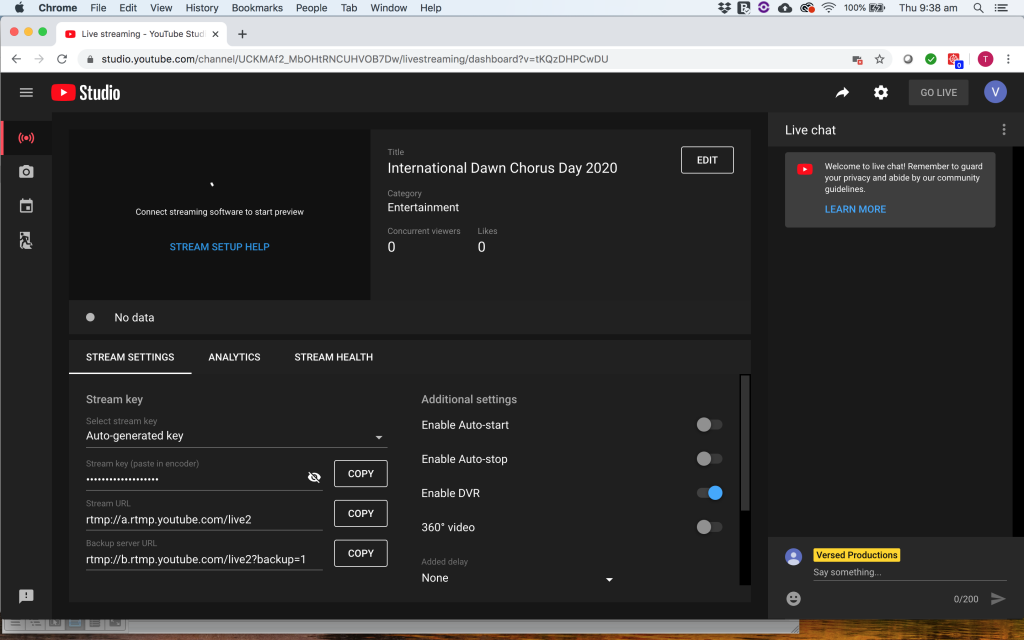Sunday 5 May was International Dawn Chorus Day 2020, and I did an audio livestream from my place near Collector (just outside Canberra) for 90 minutes around dawn to capture and share the sounds of the dawn chorus with others around the world.
I have been aware of International Dawn Chorus Day for a number of years, but never really been actively involved. The main reason for this is because the first Sunday in May is also the annual Collector Pumpkin Festival – a popular country fair which attracts around 15,000 people to our small local village that I provide live sound services for, requiring me to get up before dawn to load gear and set up onsite. With the Pumpkin Festival not being held this year due to the COVID-19 situation I figured this was a good opportunity to get involved with International Dawn Chorus Day 2020 as I’d have a bit more time on the day.
Although I have been involved with numerous events involving live streaming, I have mostly just played a supporting role in providing an audio feed. There were a few things that could go wrong, and the “live” nature of it added some adrenalin to the activity that I wouldn’t usually get from most field recording activities.
I live in a rural area that relies on a satellite connection for internet. This is usually pretty good, but has intermittent reliability and speed issues so I was a little nervous that my internet connection might not perform solidly enough. Thankfully it performed really well on the morning.
The night before I ran a couple of microphones and leads out just to see where I could get to in terms of mic placement. I wanted to be far enough away from the shed and house to avoid most noises from them such as condensation dripping into down pipes, and metal shed expansion and contraction noises. I used 35m of cables to get a reasonable distance, while still being fairly close so that I could easily keep an eye on the set-up.
I wanted to place the microphones in the top area of my paddock, as it has an area that is clear of trees so that I didn’t have the sound of wind in leaves too close in the recording/stream. One of the risks was that the couple of highland cattle that reside in the paddock might be a bit curious and either knock over mics, or step on or trip over cables.
There was always the chance that the dawn chorus might not be that active or that there might be other noise issues. It was set to be a cold morning, and at 6am it was around 2 degrees Celsius so I wasn’t sure how active the dawn chorus might turn out to be. There was also every chance that my 17 month old daughter might make a vocal appearance on the stream at some point.
Another challenge was setting appropriate gain/levels for recording and the stream. Dawn choruses can be quite dynamic, and if a bird came very close to the microphones and let loose then it would be easy for the stream to clip and be distorted. Setting the levels too low might mean it would be too quiet for people to listen to properly on their devices, and the quality could suffer. I was keen to try to retain the natural dynamic though, and I rolled with an educated guess about setting levels, and kept an eye on things in case I needed to turn up or down during the stream. Fortunately my levels were generally pretty good. I did creep them up a touch early in the stream, but only a small amount and with a fairly gentle fader move, and the stream never clipped, but got within a few dBs of 0dBFS at the highest peak during the stream.
The microphone set-up I went for was a pair of Sennheiser MKH 8040s in an ORTF configuration within a Rycote Stereo windshield. I have numerous mic options, but I opted for this as it is a really low noise and pleasant sounding option, with nice spaciousness, and the Sennheiser RF design is really good at avoiding condensation noise from the capsules that can be common on cold damp mornings.
The microphones were connected into my Sound Devices 633 mixer/recorder, which I was using for preamps, separate high resolution recording, and controlling the level being sent into the line inputs on my audio interface for the live stream.

For the streaming platform I opted for YouTube. Since I only really needed to stream audio, using a video streaming platform might seem a little over the top, but I opted for it as YouTube is a platform that everyone knows, I already had an account and I could create a visual image to go with the audio stream.
Streaming to YouTube is reasonably straight-forward, but you need to use an encoder to translate your audio and video and send it through. I used a program called OBS (Open Broadcast Software). OBS is a fantastic free, open-source software program for video recording and live streaming, that runs on Windows, Mac and Linux.
OBS allows you to select video or image sources, switch between them, and includes a basic audio mixer for control of your audio channels. To get OBS talking to YouTube you need to log into your YouTube account, start the process of building a live stream and then copy your “Stream Key” from YouTube into OBS so that OBS can direct the video and audio to YouTube.

For the visual, I just created a slide in Photoshop using a photo that I took a week earlier around dawn on ANZAC day from my verandah (I am lucky to have a beautiful view looking East). I added some text and then imported it into OBS.
The audio side was slightly more fiddly to get right for me. It all looked really easy and intuitive in OBS, but in practice I found that OBS has issues with working with firewire audio interfaces, which is what I use. I worked around this by using a program called Loopback from Rogue Ameoba to act as an intermediate path for my audio into OBS. Thankfully I have a license for my teaching work, but it is not the cheapest option at over $100USD. If you are a firewire audio interface user like me and want to use it for streaming then just note that this might be an issue that you’ll need to work around.
I didn’t pre-promote my live stream, as it was something I just figured out and set-up the night before. Once the stream was live at 6am I shared the stream URL on some social media and was pleased to see that some people tuned in from around the world, with some good feedback from a couple of people as far away as Europe and the UK.
There were a few anthropophonic sounds that popped up during the stream, the most intrusive of which was my water pump turning on a couple of times (I forgot to turn it off before I started the stream), and yes my 17 month daughter did make some noise at one point but it was quite off-axis and distant so it wasn’t too distracting.
Overall the stream went quite smoothly, and it was nice to share a wonderful dawn chorus with others around the world. There were all sorts of birds that took part, including magpies, cockatoos, wattle birds, ducks, ravens, and many more. Listening in reminded me that I don’t get up often enough to enjoy the dawn chorus fully, and I guess this is just one good reason why there is value in having a day like International Dawn Chorus Day, and for us to take the time to appreciate the value of it.
You can listen to the full recording of the stream below:
